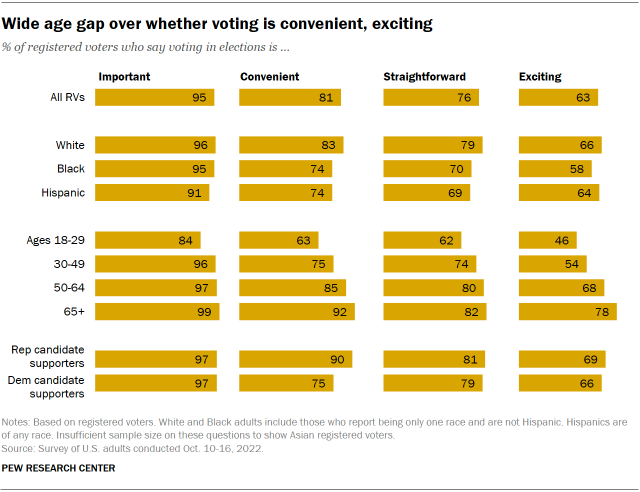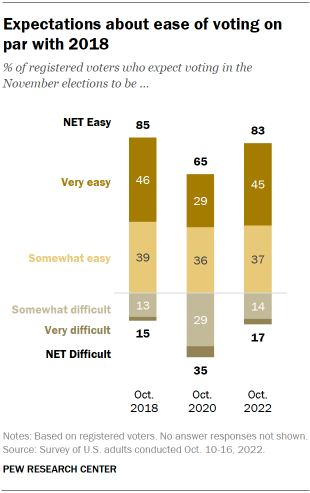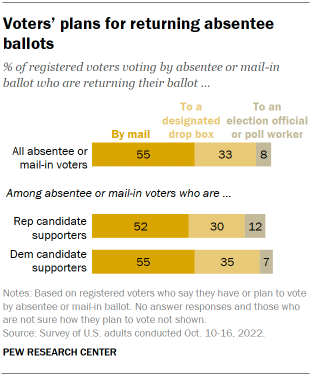Registered voters (95%) almost unanimously say voting is important. Smaller, but still substantial, majorities of voters say voting is convenient (81%), straightforward (76%) and exciting (63%).

Americans who are eligible to vote but are not registered have less positive evaluations of voting than registered voters. A majority of those who are not registered to vote say voting is important (71% say this), but about half or fewer say voting is straightforward (51%), convenient (48%) or exciting (36%).
Impressions of voting also vary across age groups. Younger registered voters, especially those under age 30, are much less likely than older voters to view voting as exciting: Nearly eight-in-ten voters 65 and older (78%) say voting is exciting; a far smaller share of voters 18 to 29 (46%) say the same.

Similarly, registered voters 65 and older (92%) are more likely than voters ages 18 to 29 (63%) to view voting as convenient. Age differences are less pronounced over whether voting is important or unimportant and straightforward or confusing.
Evaluations of voting modestly differ across racial and ethnic groups among registered voters – though, regardless of race or ethnicity, majorities say these positive traits describe voting. For instance, while 83% of White voters say voting is convenient, modestly smaller majorities of Black and Hispanic voters (74% each) say the same. And while around seven-in-ten Black (70%) and Hispanic (69%) voters say voting is straightforward, a larger share of White voters (79%) say the same.


Voters who support Republican or Democratic U.S. House candidates in this year’s elections generally give similarly positive evaluations of voting, yet a greater share of those who support Republican candidates (90%) than those who support Democratic candidates (75%) say voting is convenient.
Most voters expect it to be easy to vote in this year’s elections: 83% say it will be either very easy (45%) or somewhat easy (37%) for them to vote. Fewer than a quarter (17%) say they expect it to be difficult to vote this year.
Ahead of the presidential election in the midst of the coronavirus pandemic in October 2020, fewer voters (65%) thought voting would be easy that year. Voters’ expectations now roughly match those from the 2018 midterm elections, when 85% said they expected voting to be easy that year.

Across demographic groups, registered voters generally expect voting to be easy this year, yet voters in some groups are more likely than others to say this.
About two-thirds of Black voters (66%) say voting will be at least somewhat easy this year, compared with 75% of Hispanic voters and 87% of White voters. Roughly half of White voters (49%) say it will be very easy to vote; by comparison, 37% of Hispanic voters and 28% of Black say voting will be very easy.
Voters with college degrees are more likely than those without to expect voting to be easy. About nine-in-ten voters with a postgraduate degree (87%) or four-year college degree (88%) say voting will be easy, compared with about eight-in-ten of those with some college (79%) or a high school diploma or less (80%).
Voters who support Republican candidates (89%) are more likely than those who support Democratic candidates (80%) to expect voting to be easy. Republican supporters are also more likely to expect voting to be very easy (53% vs. 45%).
Voting in person and by mail

Most registered voters (91%) say they plan to vote or have already voted in this year’s congressional elections, with 58% planning to vote (or already having voted) in person. Overall, 42% of voters say they plan to vote in person on Election Day, and another 17% say they plan to vote in person before Election Day (or have already done so). About three-in-ten voters (28%) say they plan to vote by mail or absentee (or have already done so).
Voters who support the Republican candidate in their district are more likely than those who support the Democratic candidate to say they will vote in-person this year. A large majority of Republican supporters (72%) expect they will vote in person this year, including 54% who say they will do so on Election Day and 18% saying they will vote early. In comparison, about half (52%) of voters who support Democratic candidates say they plan to vote in-person (34% on Election Day and 18% early).
Democratic supporters are nearly twice as likely as Republican supporters to say they plan to vote by absentee or mail-in ballot this year (39% vs. 20%).
Compared with the 2020 elections, which were conducted during the first year of the coronavirus pandemic and prior to the rollout of vaccines, more voters plan to cast their ballots in person this year. About four-in-ten voters (42%) expect to vote in person on Election Day, a 9 percentage point increase compared with two years ago. The share of voters who plan to vote early in person is down modestly from 2020 (17% now, 21% then). As of today, 28% of registered voters say they expect to vote by mail, down from about four-in-ten (39%) who said this at this point in 2020.

While the share of GOP voters planning to vote on Election Day (54%) is little different from the share of Trump voters saying this in 2020 (50%), voters who support Democratic candidates today are more likely than those who backed Biden in 2020 to say this: In 2020, about half of Biden supporters (51%) said they planned to vote by mail or absentee ballot; today, 39% of voters who support Democratic candidates for Congress say they plan to vote this way. The share of Democratic supporters planning to vote early in person is also down (22% in 2020 to 18% today). About a third of Democratic supporters (34%) now say they will vote in person on Election Day this year; by comparison, 20% of Biden supporters planned to vote on Election Day in 2020.

Among registered voters who plan to vote by mail or absentee ballot (or have already voted this way), slightly more than half (55%) say they will mail their ballot back, while a third say they will use a designated drop box. About one-in-ten (7%) plan to return their ballot directly to a poll worker.
Republican and Democratic candidate supporters who are voting absentee have similar plans for returning their ballots. About the same share of Republican voters (52%) and Democratic voters (55%) will mail their ballots, use designated drop boxes (30% Republican supporters and 35% Democratic supporters) or return their ballots to election officials (12% and 7% respectively).




